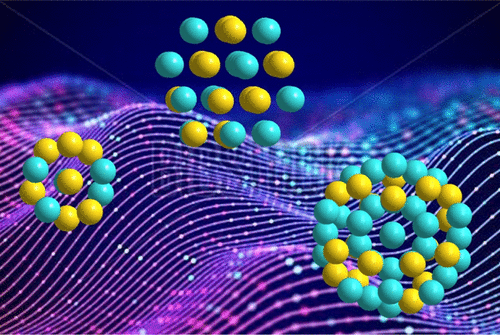当前位置:
X-MOL 学术
›
J. Chem. Inf. Model.
›
论文详情
Our official English website, www.x-mol.net, welcomes your feedback! (Note: you will need to create a separate account there.)
Basin Hopping Genetic Algorithm for Global Optimization of PtCo Clusters.
Journal of Chemical Information and Modeling ( IF 5.6 ) Pub Date : 2020-03-23 , DOI: 10.1021/acs.jcim.0c00130 Rao Huang 1 , Jian-Xiang Bi 1 , Lei Li 1 , Yu-Hua Wen 1
Journal of Chemical Information and Modeling ( IF 5.6 ) Pub Date : 2020-03-23 , DOI: 10.1021/acs.jcim.0c00130 Rao Huang 1 , Jian-Xiang Bi 1 , Lei Li 1 , Yu-Hua Wen 1
Affiliation

|
In general, searching the lowest-energy structures is considerably more time-consuming for bimetallic clusters than for monometallic ones because of the presence of an increasing number of homotops and geometrical isomers. In this article, a basin hopping genetic algorithm (BHGA), in which the genetic algorithm is implanted into the basin hopping (BH) method, is proposed to search the lowest-energy structures of 13-, 38-, and 55-atom PtCo bimetallic clusters. The results reveal that the proposed BHGA, as compared with the standard BH method, can markedly improve the convergent speed for global optimization and the possibility for finding the global minima on the potential energy surface. Meanwhile, referencing the monometallic structures in initializations may further raise the searching efficiency. For all the optimized clusters, both the excess energy and the second difference of the energy are calculated to examine their relative stabilities at different atomic ratios. The bond order parameter, the similarity function, and the shape factor are also adopted to quantitatively characterize the cluster structures. The results indicate that the 13- and the 55-atom systems tend to be icosahedral despite different degrees of lattice distortions. In contrast, for the 38-atom system, Pt10Co28, Pt11Co27, Pt17Co21, Pt19Co19, Pt20Co18, and Pt30Co8 tend to be disordered, while Pt21Co17 presents a defected face-centered cubic (fcc) structure, and the remaining clusters are perfect fcc. The methodology and results of this work have referential significance to the exploration of other alloy clusters.
中文翻译:

PtCo团簇全局优化的盆地跳跃遗传算法。
通常,由于同位异构体和几何异构体数量的增加,对于双金属簇而言,寻找最低能量的结构要比单金属簇耗时更多。本文提出了一种盆地跳跃遗传算法(BHGA),将遗传算法植入盆地跳跃(BH)方法中,以搜索13原子,38原子和55原子PtCo的最低能级结构双金属簇。结果表明,与标准的BH方法相比,所提出的BHGA可以显着提高全局优化的收敛速度,并有可能在势能面上找到全局最小值。同时,在初始化中引用单金属结构可以进一步提高搜索效率。对于所有优化的集群,计算多余的能量和能量的第二个差值,以检查它们在不同原子比下的相对稳定性。还采用键序参数,相似度函数和形状因子来定量表征团簇结构。结果表明,尽管晶格畸变程度不同,但13原子和55原子的体系往往是二十面体的。相比之下,对于38原子系统,Pt10Co28,Pt11Co27,Pt17Co21,Pt19Co19,Pt20Co18和Pt30Co8倾向于无序,而Pt21Co17具有缺损的面心立方(fcc)结构,其余簇为完美fcc。这项工作的方法和结果对其他合金团簇的勘探具有参考意义。
更新日期:2020-03-23
中文翻译:

PtCo团簇全局优化的盆地跳跃遗传算法。
通常,由于同位异构体和几何异构体数量的增加,对于双金属簇而言,寻找最低能量的结构要比单金属簇耗时更多。本文提出了一种盆地跳跃遗传算法(BHGA),将遗传算法植入盆地跳跃(BH)方法中,以搜索13原子,38原子和55原子PtCo的最低能级结构双金属簇。结果表明,与标准的BH方法相比,所提出的BHGA可以显着提高全局优化的收敛速度,并有可能在势能面上找到全局最小值。同时,在初始化中引用单金属结构可以进一步提高搜索效率。对于所有优化的集群,计算多余的能量和能量的第二个差值,以检查它们在不同原子比下的相对稳定性。还采用键序参数,相似度函数和形状因子来定量表征团簇结构。结果表明,尽管晶格畸变程度不同,但13原子和55原子的体系往往是二十面体的。相比之下,对于38原子系统,Pt10Co28,Pt11Co27,Pt17Co21,Pt19Co19,Pt20Co18和Pt30Co8倾向于无序,而Pt21Co17具有缺损的面心立方(fcc)结构,其余簇为完美fcc。这项工作的方法和结果对其他合金团簇的勘探具有参考意义。


























 京公网安备 11010802027423号
京公网安备 11010802027423号